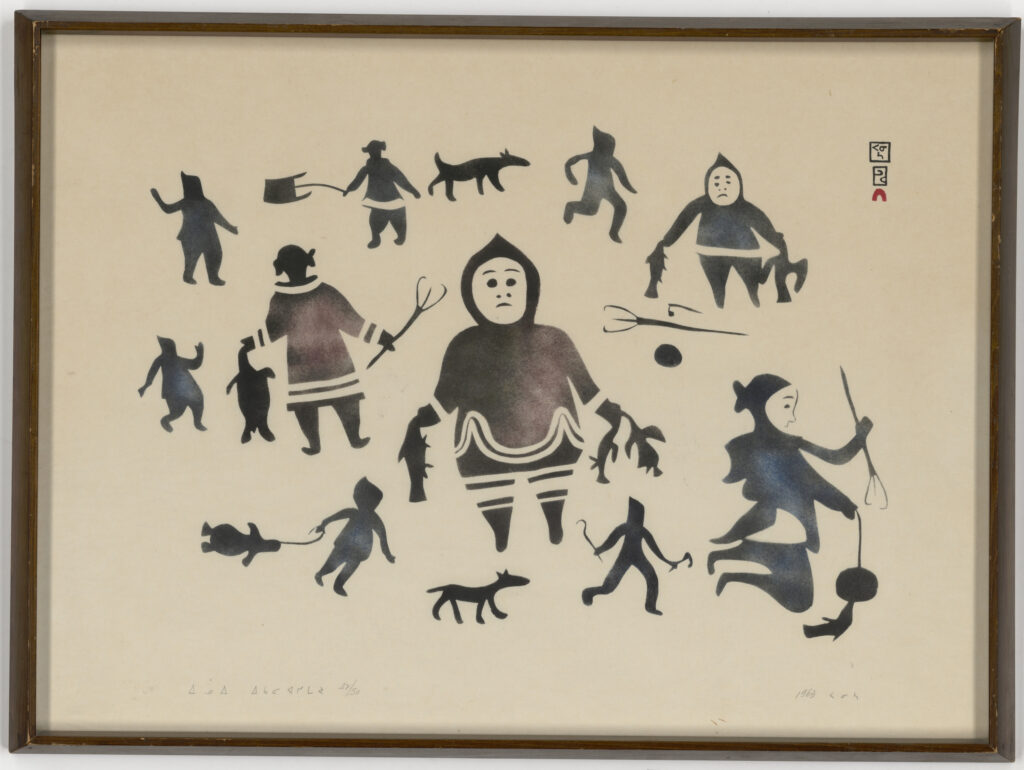By Jane O’Brien Davis (Museum Database Assistant, McGill Visual Arts Collection) and Rosalind Sweeney-McCabe (ARIA Intern, McGill Visual Arts Collection)

53.7 x 74 cm, McGill Visual Arts Collection
Born in Kinngait (formerly Cape Dorset), Nunavut, Paunichea (1920-1968) was an Inuit sculptor, graphic artist, and printmaker. Her work typically depicts birds, fish, and other animals within the tradition of stylized naturalism, a common theme among Inuit artists of the era.[1] Paunichea’s print Fishing Scene, was made towards the end of her life in 1963, and exemplifies this theme.
Kinngait, Inuktitut for “mountains”, is located on the southwest coast of Qikiqtaaluk (Baffin Island) in Nunavut. Until the early 20th century, Inuit communities were relatively unaffected by outside contact.[2] Post-WWII, however, the Canadian government’s growing concerns over Arctic sovereignty led to rapid colonization of the Inuit.[3] Fishing Scene is an important work in McGill’s Visual Art Collection as it can be seen as both an artwork and document – creating tools for Inuit cultural resilience during a time of intense colonization.
In the 1950’s, the Canadian government pushed Inuit communities into settlements, causing the traditional Inuit way of life to collapse. Inuk art historian Heather Igloliorte explains that, “while Inuit culture was being debased, devalued, and actively oppressed by the dual forces of colonization and evangelization, these same values were revered, celebrated, and preserved in their art, which was voraciously collected.”[4] The Canadian government established art cooperatives to catalogue and publish Inuit prints and other art works for the purpose of circulating it into the southern Canadian art market.[5] The Kinngait Cooperative (Cape Dorset Cooperative), established in 1959, is the most well-known of these cooperatives.
Paunichea’s Fishing Scene (1963) is one of the prints that was collected and published in Inuit print catalogues of this era. Fishing Scene is a stencil print on paper. The two most central human figures in the image are filled in with purple ink with gradation to black, the other figures are composed of blue ink with similar gradation. The people, animals, and tools in the composition work to depict the activity described by the title – fishing. The figure in the centre bares the fruit of the labour.
Fishing Scene was created during a time when the Canadian government encouraged artworks by Inuit artists to depict activities it was simultaneously attempting to erase. This contradictory desire was driven by the profitability of such scenes in the southern Canadian art market. Yet, as Igloliorte has argued, this art gave Inuit makers an opportunity to record these cultural practices, creating cultural resilience.[6] Still operational today, The Kinngait Cooperative (Cape Dorset Cooperative) continues to produce and cultivate highly innovative artwork by members of the Kinngait community.[7] This work by Paunichea, made in the early history of the Cooperative, is an example of a work which can be appreciated for both its aesthetic and documentary function.
Footnotes
[1] Jennifer Alsop, “History of Cape Dorset and the West Baffin Co-operative” May 1, 2010, https://www.westbaffin.com/new-page-1.
[2] Heather Igloliorte, “Inuit Art: Markers of Cultural Resilience.” Inuit Art Quarterly 25, no. 1 & 2 (Spring/Summer 2010): 7.
[3] Heather Igloliorte, “The Inuit of Our Imagination.” Inuit Modern: The Samuel and Esther Sarick Collection, ed. Gerald McMaster (Toronto: Art Gallery of Ontario; Vancouver: Douglas & McIntyre, 2010): 24-31.
[4] Igloliorte, “The Inuit of Our Imagination.”
[5] Igloliorte, “The Inuit of Our Imagination.”
[6] Igloliorte, “Inuit Art: Markers of Cultural Resilience”, 8.
[7] Alsop, “History of Cape Dorset and the West Baffin Co-Operative.”
Bibliography
Alsop, Jennifer. “History of Cape Dorset and the West Baffin Co-Operative.” West Baffin Eskimo Co-operative LTD., May 1, 2010. https://www.westbaffin.com/new-page-1.
Igloliorte, Heather. “Inuit Art: Markers of Cultural Resilience.” Inuit Art Quarterly 25, no. 1 & 2 (Spring/Summer 2010): 4-11.
Igloliorte, Heather. “The Inuit of Our Imagination.” Inuit Modern: The Samuel and Esther Sarick Collection. Edited by Gerald McMaster, 24-31. Toronto: Art Gallery of Ontario; Vancouver: Douglas & McIntyre, 2010.













Leave a Reply
You must be logged in to post a comment.